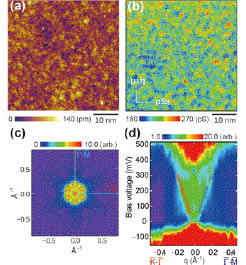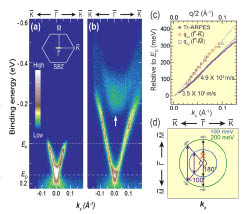Robust Protection from Backscattering in a Topological Insulator
Y. Ando, S. Shin and F. Komori
Surface of three-dimensional (3D) topological insulators (TIs) is a promising platform for novel device functions, whereon robust spin-polarized surface states occur due to topological feature of the bulk wave functions. High carrier mobility is expected on 3D TI surface because 180º backscattering is forbidden under the spin-helical texture of the topological surface states (TSSs). However, the prohibition range of backscattering has not been clarified yet. Here, we study how the elastic scattering is suppressed as functions of the scattering angle and electron energy in a single and unwarped upper Dirac cone of Bi1.5Sb0.5Te1.7Se1.3 [1]. The quaternary compound Bi1.5Sb0.5Te1.7Se1.3 is identified to a bulk-insulating TI, whose transport properties are dominated by the surface [2], and thus is suitable for investigating the TSS characteristics.

Fig. 1. (a) Topographic STM image of a cleaved surface of Bi1.5Sb0.5Te1.7Se1.3. (b) dI/dV image at the sample bias voltage Vb = 0.28 V. (c) Amplitude map of the elastic scatterings, or QPI map, derived by Fourier transformation (FT) of the dI/dV image shown in (b). (d) FT amplitude image in Γ-K and in Γ-M directions as functions of Vb. Critical scattering-vector lengths are plotted as red and blue symbols.

Fig. 2. (a,b) Intensity maps of ARPES before (a) and after (b) impinging a 170-fs pump laser pulse (1.5 eV). The dispersions above EF are revealed by pumping the electrons into the unoccupied side. An arrow in (b) indicates the bottom of the bulk conduction band. (c) Comparison between critical scattering-vector lengths qcx and qcy (red and blue symbols) obtained from QPI images and the dispersion of the TSS (circles) from pump-probe ARPES. (d) Schematic of the elastic scattering within a nearly ideal Dirac TSS. Scattering angle larger than 100º is effectively prohibited.
The elastic-scattering vector within the TSS on the cleaved surface was obtained from a quasiparticle interference (QPI) pattern, which is a Fourier-transformed constant-voltage dI/dV image measured using scanning tunneling microscopy at 5 K (Fig. 1). The observed elastic scattering amplitude within the TSS was critically suppressed beyond certain scattering-vector lengths, both in the Γ-M and in Γ-K directions. That is, there is a critical scattering-vector length, qc, beyond which the scattering is effectively prohibited. The critical length increased with the increase of energy from the Dirac point as shown in Fig. 1(d). The band dispersions displayed in Fig. 2(a,b) were recorded by using angle-resolved photoemission spectroscopy (ARPES) implemented by a pump-and-probe method. Here, the dispersions above the Fermi level were revealed by pumping electrons into the unoccupied states (Fig. 2(b)). A nearly ideal Dirac-cone dispersion was observed within the bulk band gap. The locus of the Dirac point, bulk-conduction-band minimum, and the band velocity of the TSS were obtained. We find that the critical scattering vector length is 75 % shorter than the length of the 180o backscattering vector (Fig. 2(c)). This indicates that the scattering in the TSS is effectively prohibited in a wide angular range of 100-180o as schematically shown in Fig. 2(d). The robust protection from backscattering is good news for applications, but it poses a challenge to the theoretical understanding of the transport in the TSS.
References
- [1] S. Kim, et al., Phys. Rev. Lett. 112, 136802 (2014).
- [2] A. A. Taskin et al., Phys. Rev. Lett. 109, 066803 (2012).
